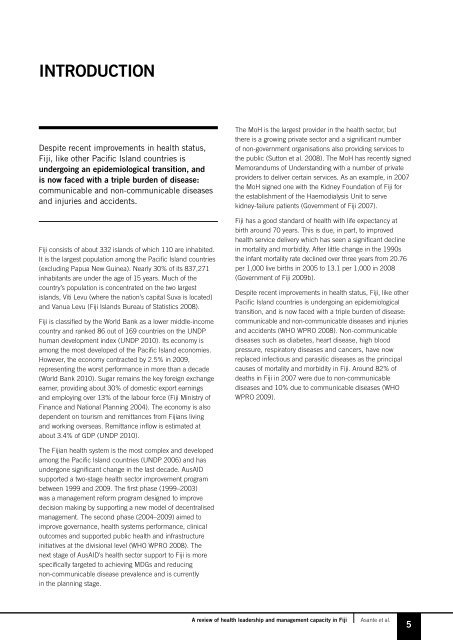a review of health leadership and management capacity in fiji - HRH ...
a review of health leadership and management capacity in fiji - HRH ...
a review of health leadership and management capacity in fiji - HRH ...
You also want an ePaper? Increase the reach of your titles
YUMPU automatically turns print PDFs into web optimized ePapers that Google loves.
INTRODUCTION<br />
Despite recent improvements <strong>in</strong> <strong>health</strong> status,<br />
Fiji, like other Pacific Isl<strong>and</strong> countries is<br />
undergo<strong>in</strong>g an epidemiological transition, <strong>and</strong><br />
is now faced with a triple burden <strong>of</strong> disease:<br />
communicable <strong>and</strong> non-communicable diseases<br />
<strong>and</strong> <strong>in</strong>juries <strong>and</strong> accidents.<br />
Fiji consists <strong>of</strong> about 332 isl<strong>and</strong>s <strong>of</strong> which 110 are <strong>in</strong>habited.<br />
It is the largest population among the Pacific Isl<strong>and</strong> countries<br />
(exclud<strong>in</strong>g Papua New Gu<strong>in</strong>ea). Nearly 30% <strong>of</strong> its 837,271<br />
<strong>in</strong>habitants are under the age <strong>of</strong> 15 years. Much <strong>of</strong> the<br />
country’s population is concentrated on the two largest<br />
isl<strong>and</strong>s, Viti Levu (where the nation’s capital Suva is located)<br />
<strong>and</strong> Vanua Levu (Fiji Isl<strong>and</strong>s Bureau <strong>of</strong> Statistics 2008).<br />
Fiji is classified by the World Bank as a lower middle-<strong>in</strong>come<br />
country <strong>and</strong> ranked 86 out <strong>of</strong> 169 countries on the UNDP<br />
human development <strong>in</strong>dex (UNDP 2010). Its economy is<br />
among the most developed <strong>of</strong> the Pacific Isl<strong>and</strong> economies.<br />
However, the economy contracted by 2.5% <strong>in</strong> 2009,<br />
represent<strong>in</strong>g the worst performance <strong>in</strong> more than a decade<br />
(World Bank 2010). Sugar rema<strong>in</strong>s the key foreign exchange<br />
earner, provid<strong>in</strong>g about 30% <strong>of</strong> domestic export earn<strong>in</strong>gs<br />
<strong>and</strong> employ<strong>in</strong>g over 13% <strong>of</strong> the labour force (Fiji M<strong>in</strong>istry <strong>of</strong><br />
F<strong>in</strong>ance <strong>and</strong> National Plann<strong>in</strong>g 2004). The economy is also<br />
dependent on tourism <strong>and</strong> remittances from Fijians liv<strong>in</strong>g<br />
<strong>and</strong> work<strong>in</strong>g overseas. Remittance <strong>in</strong>flow is estimated at<br />
about 3.4% <strong>of</strong> GDP (UNDP 2010).<br />
The MoH is the largest provider <strong>in</strong> the <strong>health</strong> sector, but<br />
there is a grow<strong>in</strong>g private sector <strong>and</strong> a significant number<br />
<strong>of</strong> non-government organisations also provid<strong>in</strong>g services to<br />
the public (Sutton et al. 2008). The MoH has recently signed<br />
Memor<strong>and</strong>ums <strong>of</strong> Underst<strong>and</strong><strong>in</strong>g with a number <strong>of</strong> private<br />
providers to deliver certa<strong>in</strong> services. As an example, <strong>in</strong> 2007<br />
the MoH signed one with the Kidney Foundation <strong>of</strong> Fiji for<br />
the establishment <strong>of</strong> the Haemodialysis Unit to serve<br />
kidney-failure patients (Government <strong>of</strong> Fiji 2007).<br />
Fiji has a good st<strong>and</strong>ard <strong>of</strong> <strong>health</strong> with life expectancy at<br />
birth around 70 years. This is due, <strong>in</strong> part, to improved<br />
<strong>health</strong> service delivery which has seen a significant decl<strong>in</strong>e<br />
<strong>in</strong> mortality <strong>and</strong> morbidity. After little change <strong>in</strong> the 1990s<br />
the <strong>in</strong>fant mortality rate decl<strong>in</strong>ed over three years from 20.76<br />
per 1,000 live births <strong>in</strong> 2005 to 13.1 per 1,000 <strong>in</strong> 2008<br />
(Government <strong>of</strong> Fiji 2009b).<br />
Despite recent improvements <strong>in</strong> <strong>health</strong> status, Fiji, like other<br />
Pacific Isl<strong>and</strong> countries is undergo<strong>in</strong>g an epidemiological<br />
transition, <strong>and</strong> is now faced with a triple burden <strong>of</strong> disease:<br />
communicable <strong>and</strong> non-communicable diseases <strong>and</strong> <strong>in</strong>juries<br />
<strong>and</strong> accidents (WHO WPRO 2008). Non-communicable<br />
diseases such as diabetes, heart disease, high blood<br />
pressure, respiratory diseases <strong>and</strong> cancers, have now<br />
replaced <strong>in</strong>fectious <strong>and</strong> parasitic diseases as the pr<strong>in</strong>cipal<br />
causes <strong>of</strong> mortality <strong>and</strong> morbidity <strong>in</strong> Fiji. Around 82% <strong>of</strong><br />
deaths <strong>in</strong> Fiji <strong>in</strong> 2007 were due to non-communicable<br />
diseases <strong>and</strong> 10% due to communicable diseases (WHO<br />
WPRO 2009).<br />
The Fijian <strong>health</strong> system is the most complex <strong>and</strong> developed<br />
among the Pacific Isl<strong>and</strong> countries (UNDP 2006) <strong>and</strong> has<br />
undergone significant change <strong>in</strong> the last decade. AusAID<br />
supported a two-stage <strong>health</strong> sector improvement program<br />
between 1999 <strong>and</strong> 2009. The first phase (1999–2003)<br />
was a <strong>management</strong> reform program designed to improve<br />
decision mak<strong>in</strong>g by support<strong>in</strong>g a new model <strong>of</strong> decentralised<br />
<strong>management</strong>. The second phase (2004–2009) aimed to<br />
improve governance, <strong>health</strong> systems performance, cl<strong>in</strong>ical<br />
outcomes <strong>and</strong> supported public <strong>health</strong> <strong>and</strong> <strong>in</strong>frastructure<br />
<strong>in</strong>itiatives at the divisional level (WHO WPRO 2008). The<br />
next stage <strong>of</strong> AusAID’s <strong>health</strong> sector support to Fiji is more<br />
specifically targeted to achiev<strong>in</strong>g MDGs <strong>and</strong> reduc<strong>in</strong>g<br />
non-communicable disease prevalence <strong>and</strong> is currently<br />
<strong>in</strong> the plann<strong>in</strong>g stage.<br />
A <strong>review</strong> <strong>of</strong> <strong>health</strong> <strong>leadership</strong> <strong>and</strong> <strong>management</strong> <strong>capacity</strong> <strong>in</strong> Fiji<br />
Asante et al.<br />
5
















